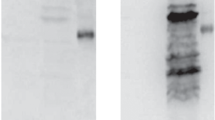Abstract
The yeast Candida maltosa can utilize L-lysine as sole nitrogen and sole carbon source accompanied by accumulation of ε-N-acetyl-L-lysine, indicating that lysine is metabolized by way of N-acetylated intermediates. A novel lysine acetyltransferase catalyzing the first step in this pathway, the N-acetylation of the ε-amino group of L-lysine, was found in this yeast. The enzyme, acetyl-CoA:L-lysine N-acetyltransferase, is strongly induced in cells grown on L-lysine as sole carbon source. The enzyme is specific for both L-lysine and acetyl-CoA. The K m values are 10 mM for L-lysine and 0.33 mM for acetyl-CoA. The enzyme has a maximum activity at pH 8.1.
Similar content being viewed by others
References
Casper P, Bode R, Samsonova IA, Birnbaum D (1985) Untersuchungen zum Glutamat/Aspartat-Metabolismus von Candida maltosa. J Basic Microbiol 25:637–643
Chirpich TP, Zappia V, Costilow RN, Barker HA (1970) Lysine 2,3-aminomutase. Purification and properties of a pyridoxal phosphate and S-adenosylmethionine activated enzyme. J Biol Chem 245:1778–1789
Gaillardin C, Fournier P, Sylvestre G, Heslot H (1976) Mutants of Saccharomycopsis lipolytica defective in lysine catabolism. J Bacteriol 125:48–57
Hedrick LR, DuPont PD (1968) The utilization of L-amino acids as carbon source by yeast of the genera Hansenula and Trichosporon. Antonie van Leeuwenhoek Microbiol Serol 40:465–473
Higashino K, Tsukada K, Liberman L (1965) Saccharopine, a product of L-lysine breakdown by mammalian liver. Biochem Biophys Res Commun 20:285–290
Kinzel JJ, Winston MK, Bhattacharjee KK (1983) Role of L-lysine-α-ketoglutarate aminotransferase in catabolism of lysine as a nitrogen source for Rhodotorula glutinis. J Bacteriol 155:417–419
Kusakabe H, Kodama K, Kuninaka A, Yoshino H, Misono H, Soda K (1980) A new antitumor enzyme, L-lysine α-oxidase from Trichoderma viride. Purification and enzymological properties. J Biol Chem 255:976–981
Lowry OH, Rosebrough NJ, Farr AL, Randall RJ (1951) Protein measurement with the Folin phenol reagent. J Biol Chem 193:265–275
Misono H, Nagasaki S (1982) Occurrence of L-lysine ε-dehydrogenase in Agrobacterium tumefaciens. J Bacteriol 150:398–401
Paik WK, Kim S (1964) Enzymic synthesis of ε-N-acetyl-L-lysine. Arch Biochem Biophys 108:221–229
Rothstein M (1965) Intermediates of lysine dissimilation in the yeast, Hansenula saturnus. Arch Biochem Biophys 111:467–476
Sabo DL, Boaker EA, Byers B, Waron H, Fisher EH (1974) Purification and physical properties of inducible Escherichia coli lysine decarboxylase. Biochemistry 13:662–670
Schmidt H, Bode R, Birnbaum D (1988) A novel enzyme, L-lysine: pyruvate aminotransferase, catalyses the first step of lysine catabolism in Pichia guilliermondii. FEMS Microbiol Lett 49:203–206
Schultz AS, Pomper S (1948) Amino acids as nitrogen source for the growth of yeasts. Arch Biochem Biophys 19:184–192
Soda K, Misono H (1968) L-Lysine-α-ketoglutarate aminotransferase. II. Purification, crystallization, and properties. Biochemistry 7:4110–4119
Takagi M, Kawai S, Takata Y, Tanaka N, Sunariri M, Miyazaki M, Yano K (1985) Induction of cycloheximide resistance in Candida maltosa by modifying the ribosomes. J Gen Appl Microbiol 31:267–275
Takeda H, Hayaishi O (1966) Crystalline L-lysine oxygenase. J Biol Chem 241:2733–2736
Tanaka A, Ohishi N, Fukui S (1967) Studies on the formation of vitamins and their function in hydrocarbon fermentation. Production of vitamin B6 by Candida albicans in hydrocarbon medium. J Ferment Technol 45:617–623
Vogel HJ (1960) Two modes of lysine synthesis among lower fungi: evolutionary significance. Biochim Biophys Acta 41:172–173
Vogel HJ, Shimura Y (1971) Spectrophotometric determination of lysine. In: Tabor H, Tabor CW (eds) Methods in enzymology, vol 17B. Academic Press, New York London, pp 228–229
Walters LS, Thiselton MR (1953) Utilization of lysine by yeasts. J Inst Brew 59:401–404
Author information
Authors and Affiliations
Additional information
Dedicated to Prof. Dr. F. Böttcher in occasion of his 60th birthday
Rights and permissions
About this article
Cite this article
Schmidt, H., Bode, R. & Birnbaum, D. Lysine degradation in Candida maltosa: occurrence of a novel enzyme, acetyl-CoA: L-lysine N-acetyltransferase. Arch. Microbiol. 150, 215–218 (1988). https://doi.org/10.1007/BF00407782
Received:
Accepted:
Issue Date:
DOI: https://doi.org/10.1007/BF00407782




